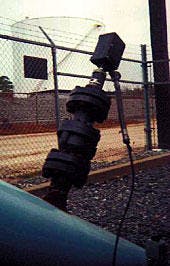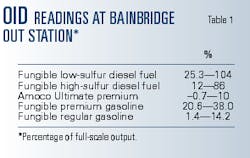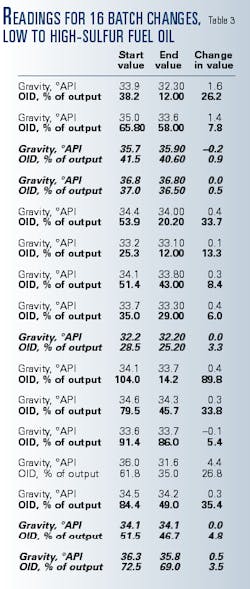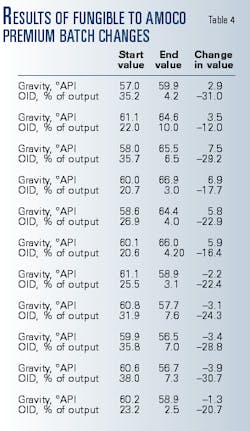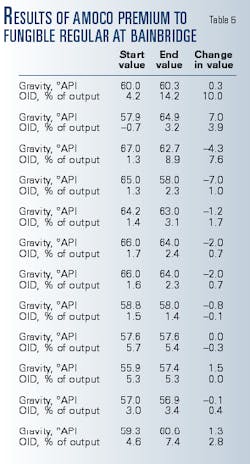Colonial Pipeline tests interface-detector methods
Pilot testing in 2000 of an optical interface detector (OID) on a Colonial Pipeline Co. stubline in Georgia has indicated that the detector cannot by itself identify a product type flowing in a pipeline.
When paired with a gravitometer, however, the twin installation improved efficiency and quality control. The prospects are that it will free personnel to focus less on basic manual tasks and more on those requiring analysis and judgment for operational and integrity-related projects and solutions.
The ultimate benefit of the OID technology is not solely efficiency, Colonial's project suggests; it is also the opportunity to improve pipeline operations.
Optical detector
Colonial Pipeline launched its pilot program to bring additional automation and remote control capability to its 254 mile, 12-in. stubline, informally called the "Bainbridge Line" after its termination point. The line originates west of Atlanta and delivers refined petroleum products to shipper terminals in southern Georgia.
Project objectives included upgrading and standardizing facility control equipment, automating the ticketing process, and improving transition control of deliveries from local operators to controllers in Colonial's Atlanta pipeline control center.
The scope of work included an examination of the instrumentation used to track batches along the pipeline system.
The Bainbridge Line is a multi-product pipeline that transports several grades of gasoline, two grades of fuel oil, and kerosene. Fig. 1 displays a typical batch sequence for the line.
The line serves terminals at Griffin, Macon, Americus, Albany, and Bainbridge. Deliveries at intermediate terminals (upstream of Bainbridge) are typically accomplished by stripping from the passing batches and avoid the interfaces between product grades. At Bainbridge delivery, operations must deal with the interfaces between products.
In the design of the automation project, Colonial recognized that proper detection of the beginning and end of the interfaces at Bainbridge was critical to the integrity of product quality, as well as to delivery operations for Bainbridge customers. To this point, it had been Colonial's practice to have a pipeline operator present to "catch" all product interfaces.
An objective of the automation project was to apply instrumentation that would eliminate the need for manual cuts between all but a few interfaces. Colonial's automation designers agreed that existing instrumentation would not provide the degree of confidence needed to make remote cuts between certain product types, in particular between a segregated premium gasoline and other gasolines and between low sulfur and high-sulfur diesel fuels.
In pursuit of this goal, Colonial installed a new device, an optical interface detector (OID) developed by Kam Controls Inc., Houston.
The OID transmits known wavelength of light into the flowing medium through a 600-µ lens. The receiver lens (also 600 µ), which is parallel to the transmit lens, transports the optical signature of the flowing medium to the photo analyzer. The photo analyzer then communicates the optical signature to the OID controller and finally to the user.
The OID is designed with an insertable probe that fits into existing or hot tapped 1 or 2-in. threaded connection or 2 or 3-in. flanges. It provides a standard 4-20 ma output signal, which can be easily input to control center instrumentation systems requiring no special tools or training for technicians or operators.
Typical installation requires little or no construction and takes 1 or 2 days to complete. The OID probes, as installed, protrude approximately 2 in. into the pipeline and must be retracted to allow for passage of cleaning or internal inspection tools.
The manufacturer expects the probes to work just as well with the probe at the internal diameter of the pipeline, which allows for scraper passage without the probe having to be manually retracted. Alternatively, the probe can be installed in a flow loop to the side of the pipeline.
Fig. 2 shows the OID installation at Bainbridge delivery. At the same time as the OID installation, the existing gravitometer at Bainbridge was replaced with a Solartron Mobrey Ltd. gravitometer for more accurate gravity readings. Colonial also installed an "out station" 5,500 bbl (or approximately 7 pipeline miles) upstream of Bainbridge delivery.
Past experience had shown that the lengths of the interfaces received at Bainbridge were unpredictable and varied with flow rate, product types, the number of times the interface stopped en route to Bainbridge, and the amount of drag-reducing agent injected into the product stream.
A gravitometer and an OID device were installed at the out station to preview the interfaces to the pipeline controller as they approached Bainbridge delivery.
Results
Based on the OID readings (percentage of full-scale output), Colonial Pipeline concluded in this pilot project that the OID device cannot be used solely to identify a product type. Table 1 shows the readings that led to this conclusion.
The purpose of the interface detecting equipment, however, is not necessarily to identify a product type according to a given set of parameters. The purpose, rather, is to identify an interface between batches based on a change in composition of product passing the probe.
The change in product is determined by changes in the measured product gravities and changes in the output of the OID device range as shown in Table 2.
Table 3 presents values for the beginning and end readings of the API gravity and OID output for 16 batch changes from low sulfur to high-sulfur fuel oil. These results show that the readings from the OID can vary widely while the change in gravity from low sulfur to high-sulfur product occurs in a very narrow range.
Table 3 indicates that the OID would have enhanced a pipeline controller's ability reliably to detect the low sulfur to high-sulfur transition in 10 of the 16 occurrences shown (boldfaced type) with a more definitive indication of change.
In these instances, the API gravity change was less than 2° and the OID output change was greater than 5%. Neither the gravitometer nor the OID would have reliably detected the interface on five occasions (boldfaced italic type), and an operator would have been called to the site to identify the batch change manually.
Table 4 presents results of the fungible premium to segregated premium gasoline product batch changes for 11 batch changes.
For these interfaces, it would appear that either the gravitometer or the OID device could be used independently to identify the interface in almost every instance. The indications from either instrument could be used to support or confirm the indications of the other, thereby increasing the confidence of the pipeline controller that he has correctly identified the interface.
Table 5 presents results of the segregated premium gasoline to fungible regular for 12 batch changes at Bainbridge. This table shows that the OID offers no particular advantage over the gravitometer in detecting these interfaces, as there is no consistent pattern of one instrument's reading displaying a greater change than the other instrument.
At this time, Colonial is not considering the batch change between gasoline and distillate products for remote operation because neither the gravitometer nor the OID will indicate flash point. These batch changes will continue to be handled manually for now.
The readings from the out station OID and gravitometer correlate with the readings from the instruments at Bainbridge.
Colonial is considering installing an OID to the first delivery facility upstream of Bainbridge. This will allow the pipeline controller time call an operator out to Bainbridge if the instrumentation fails to give a clear depiction of the interface as it passes the upstream delivery.
Although the combination of the OID and gravitometer will not eliminate the need, it has the potential significantly to reduce the number operator callouts.
Next steps
All batches to date have been accomplished manually with the data from the gravitometer and OID recorded to estimate the potential for successful remote batch cuts. The next step is to take the data and develop criteria that the pipeline controller can use to make remote cuts successfully.
Once the criteria have been established, the next phase of testing will be to have the controller make the cuts with the operator at Bainbridge observing the operation and intervening only if necessary. When it has been satisfactorily demonstrated that remote batch cutting is possible, the presence of the local operator will no longer be required for many of the interfaces at Bainbridge.
Colonial is also testing the OID device on its two mainlines that deliver products into its tank farm at Greensboro, NC. One mainline transports only gasoline and the other only distillate products.
OID devices installed at Colonial's tank farm in Charlotte provide mainline controllers in Colonial's Atlanta control center and the tank farm operators at Greensboro with a preview of the interfaces as they move toward Greensboro. Greensboro is a staffed facility, and the OIDs are being utilized to reduce the number of personnel hours devoted to manually sampling the incoming product streams.
At this time, the combination of gravity and OID readings has reduced the personnel hours required to "catch" the batch change in the sample house by approximately 70% on Colonial's gasoline line at the Greensboro tank farm.
The author
Victor A. Yarborough is vice-president for technology and operational excellence at Colonial Pipeline Co., Atlanta, which he joined in 1972. He holds a mechanical engineering degree from the Georgia Institute of Technology, Atlanta. He is a member of API's pipeline operations and technical committee for liquid pipelines and ASME and represents the oil pipeline industry on the board of the Common Ground Alliance initiative. Yarborough is a ® professional engineer in Georgia.


